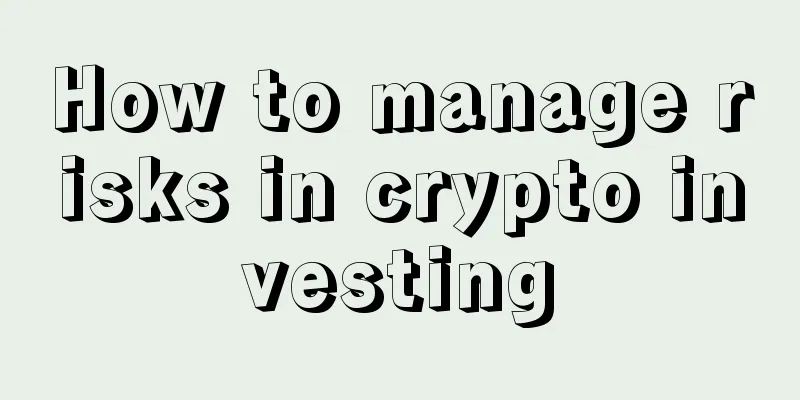How to manage risks in crypto investing

|
How to distinguish between gamblers and investors? The easiest way is to observe whether he can control the risks. People who are new to investing may find that even in the last bull market, many people still lost money. The endless myths of getting rich quickly in the market make investors FOMO. Everyone thinks they will succeed in the end, but in the end there are always people who keep losing more money. When many people 'FOMO' in at the top, that ultimately causes them to be thrown out at the bottom.
Types of Risk Risk is your best friend and worst enemy in this market. Here are the different risk categories:
These risks can be divided into the following categories:
Qualities Needed for Successful Investing Stable mentality One thing that can help you manage risk is to control your emotions and keep a healthy perspective on past events. Bad trades and missed opportunities can take a huge toll on your mental health if you constantly blame yourself for them. Morgan, the author of "The Psychology of Money", has discussed this issue. As a successful liquidity miner and former online poker player, he said that you should not pay too much attention to what happened in the past. They can only be experiences and cannot influence your emotions. A common advantage of successful risk asset managers is their knowledge reserve. In addition to studying human psychology and emotional control, most excellent ones also have a solid understanding of finance, strong mathematical ability, sound fundamental cognition and technical analysis tools and strategies. Choosing how much of your net worth to allocate to high-, medium-, or low-risk investments can be done by taking a moment to think about your long-term goals, the investment cycle you expect, and how much wealth you hope to have by your maturity date. A good way to rethink your risk exposure is to imagine the future of a project using the worst-case scenario. And determine different percentages of investment categories for each high, medium, and low risk. If you think something has a 90% risk of going to zero, maybe don't put more than 10% of your high-risk volume or 1% of your total net assets in it. Maintaining a stable risk exposure over the long term is a healthy investment approach. This is also a key skill that professional risk managers must maintain at all times. Something that may have a 90% downside risk is still worth holding on to for a bit; but it must have a 9,000% upside potential. Being able to determine this risk-reward ratio and allocate it appropriately is a must in the capital allocation business. Maintain self-discipline Risk management has always been the most important yet least popular investment topic, so being able to maintain self-discipline will defeat most people. Those who take the time to learn and understand these basics will have a huge advantage over the other 80% of market participants. The question you always need to think about before investing is survival. Surviving is the most important thing. Most of the time in trading and investing is about being patient, waiting for a good opportunity to invest, and waiting for your ultimate perception to be proven successful or invalid by the market. Through this process, accumulate your own personal knowledge and investment portfolio skills, effective methodology, and always put risk first, and believe that as time goes by, the market will reward you with these knowledge. |
>>: Sanctions are a driving factor for Bitcoin adoption
Recommend
Coinbase to go public on April 14! Announces Q1 earnings ahead of schedule -
Cryptocurrency giant Coinbase announced on Thursd...
31 Chinese companies form financial blockchain cooperation alliance
Baozou Commentary : In May this year, 31 domestic...
A complete analysis of the facial features of people with several wrinkles in the center of the forehead
The lines on the forehead of different people are...
What does it mean when the skin under the left eye twitches?
I believe everyone has experienced eyelid twitchi...
What is the difference between peach blossom eyes and almond eyes?
Among the many eye shapes, almond eyes and peach ...
Dai Jiale: Detailed explanation of the essence, technical architecture and application of IPFS
Last Sunday, Blockchain Catcher held the second C...
What kind of face does a woman have to have a good life?
Do you want to make your destiny blessed? What ki...
Where is the location of the mole of misery?
Where is the mole of misery located ? Each of us ...
Chia's new model catalyzes the shortage of hard disk storage devices
Author: Song Jiaji, Ren Heyi Industry Comments Re...
Shang Silin, President of Mars Cloud Mining: The first round of Filecoin is about to enter the finish line
On July 3-4, 2020, the 2020 IPFS Ecosystem and Di...
Will people with asymmetrical nasolabial folds have bad luck in their lives? What are the effects of asymmetrical nasolabial folds?
Is the career of a person with asymmetrical nasol...
What is a dimple? Dimple face analysis
Many people don’t know what dimples are. Dimples ...
JPMorgan Chase is exploring cryptocurrency clearinghouse options
According to Forbes, JPMorgan Chase is currently ...
What does a mole on the palm mean? Is a mole on the palm a lucky mole?
Moles in different positions have different meani...
What kind of people have high education?
Highly educated appearance (1) The earlobe is lon...









